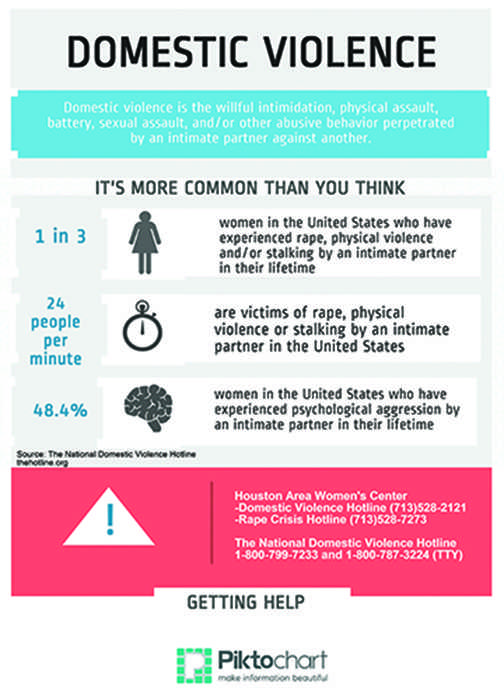Push to educate about domestic violence
April 15, 2014

Every nine seconds in the United States, a woman is assaulted or beaten, according to domesticviolencestatistics.org.
Domestic violence cannot be stopped, but warning signs and escape plans can be taught to women.
The root of the problem is the abusers, though, and that’s why there needs to be education about the dangers of abuse as early as elementary school.
Stricter laws also need to be put in place in order to protect abuse survivors and ensure that more women do not become another statistic.
This form of abuse occurs in an intimate relationship and can take many forms, including physical, emotional and psychological. Stalking, economic deprivation and sexual abuse can also occur.
It can happen to anyone, regardless of race, socioeconomic background, religion, or age. Men are also victims of domestic abuse.
The point is that abuse is never acceptable, no matter who it comes from
Everybody deserves a healthy, loving relationship in which they feel respected and valued.
Although domestic violence is the leading cause of injury to women, it is still not talked openly about in the public. The survivors face endless harassment, physical and psychological trauma, as well as the harsh stigma that comes with being in an abusive relationship.
There’s a misconception that those in a abusive relationship can just walk away from it, and that if they don’t leave, then they’re weak or irresponsible.
However, domestic abuse is multifaceted. There are a multitude of dangers involved in abruptly leaving a violent relationship.
If the victim were to leave suddenly, they could easily be stalked, harassed, or be put into even more danger than while in the relationship.
Women need to be given safe escape methods, such as going to a protected women’s shelter or calling a safe hotline for further advice.
It’s important for people to know the signs of abuse before they occur. Ensuring that students learn about relationships, abuse and family management will instill a set of values and understanding of what a healthy relationship looks like.
According to domesticviolencestatistics.org, men who as children witnessed their parents’ domestic violence were twice as likely to abuse their own wives than sons of nonviolent parents.
Violence is the only thing some people know, yet this chain can be broken by understanding that there is a life outside of abuse.
The Supreme Court has recently proven to be on the side of the survivor, fortunately. On March 26, The Supreme Court enforced a federal law preventing people convicted of minor domestic violence offenses from owning guns. This law is one step in the right direction, however, more needs to be done.
All women involved in any type of abusive relationship, whether they are married, dating or gay, should have equal protection under the law. Also, immigrants in the country should be protected, rather than keep quiet about their abuse due to fear of deportation.
Abuse cannot be stopped overnight. Yet, proper education, awareness and stricter laws will aid in preventing more people from becoming victims to this senseless suffering.

